
OUT WITH THE BATHWATER: Retirement brain drain is the loss of critical skills and experience required to maintain the workforce when seasoned employees retire en masse. (Image by Getty Images)
Despite concerns of brain drain and a dearth of mid-level experience, the Army Acquisition Workforce is not currently suffering the predicted widespread exit of skilled workers.
by Daniel E. Stimpson, Ph.D.
For more than two decades, many human resources experts, university professors, consultants and think tanks have issued warnings and feared the worst about the current period. Namely, what will happen when the baby boomers retire?
The primary concern is related to the loss of the critical skills and experience required to maintain and improve the workforce as a high volume of seasoned employees exit the federal ranks in retirement. This situation, also known as “retirement brain drain,” has the potential to leave organizations with a talent vacuum.
Figure 1, shows the distribution of the civilian Army Acquisition Workforce (AAW) in 2013, where 49 percent of the workforce was either retirement eligible or within 10 years of eligibility. In 2016, the DOD Acquisition Workforce Strategic Plan put this number at 57 percent for the entire DOD acquisition workforce. Clearly, the situation appeared daunting.
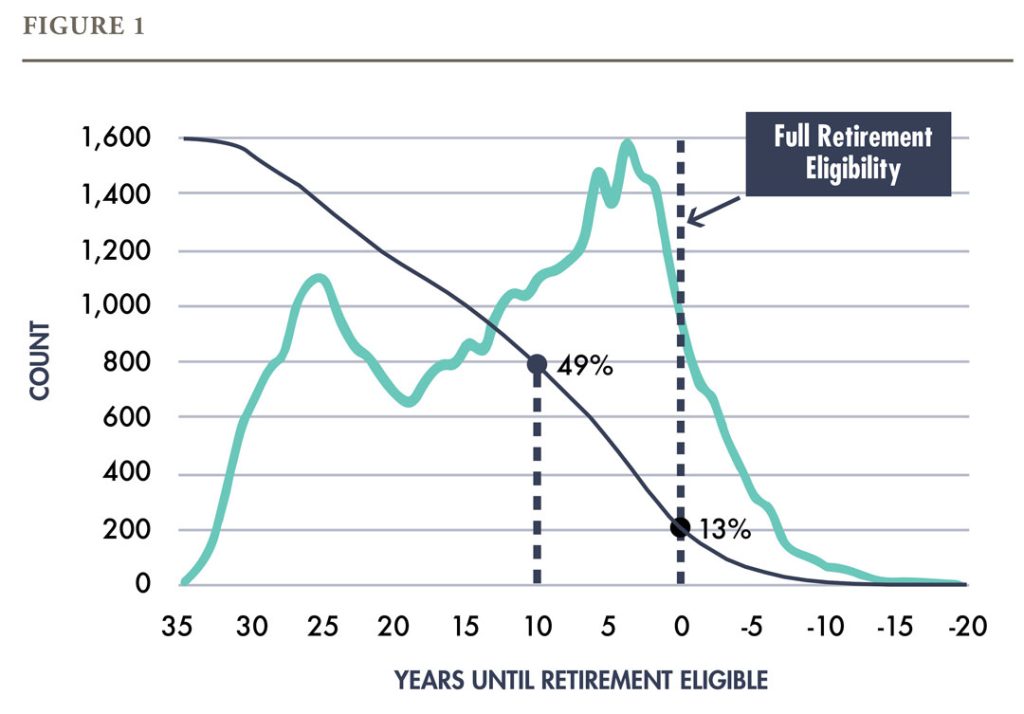
ALMOST THERE: This graphic illustrates the AAW 2013 Civilian Employee Retirement Eligibility Distribution. (Source: The Career Acquisition Personnel and Position Management Information System [CAPPMIS]. Graphics by USAASC)
The term “bathtub” is used to describe the shape of the workforce distribution that was simultaneously overrepresented with senior acquisition professionals and underrepresented by mid-level employees. This situation became especially concerning because of the significant threat of experience-loss coupled with a shortage of qualified mid-level leaders to succeed those retiring.
The origin of the bathtub and the related concerns can be traced back to hiring freezes in the 1990s. In 2000, the undersecretaries of defense for acquisition, technology and logistics and for personnel and readiness said that “after 11 consecutive years of downsizing, we face serious imbalances in the skills and experience of our highly talented and specialized civilian workforce. Further, 50 percent will be eligible to retire by 2005. In some occupations, half of the current employees will be gone by 2006.”
The Acquisition Advisory Panel reported to the U.S. Congress in 2007: “During the 1990s, the federal acquisition workforce was significantly reduced and hiring virtually ceased, creating what has been termed the ‘bathtub effect,’ a severe shortage of procurement professionals with between five and 15 years of experience. The impact of this shortage is likely to be felt more acutely soon, as half of the current workforce is eligible to retire in the next four years.”
In fact, this situation progressed to the point that, in 2005, the Defense Acquisition University (DAU) reported that 76 percent of the acquisition, logistics and technology workforce were baby boomers or older. Even as recently as last year, researchers at the Naval Postgraduate School were still indicating that a “sharp (natural and unavoidable) shrinkage of the workforce” could be expected as senior professionals reach retirement age and “it is self-evident that such large changes in the number and composition of the workforce must be highly disruptive.”
WHAT ACTUALLY HAPPENED IN THE AAW?
These forecasts motivated senior defense acquisition leaders to take action and maintain focus on filling the bathtub. This was accomplished by persistently framing strategy and policy decisions over the course of decades. To date, these many remedies appear to have been effective in the AAW, as nothing that can be characterized as “sharp” has occurred. Rather, as Figure 2, shows, the distribution of civilian AAW employees has been smoothly transitioning over the last nine years, the period for which high resolution data are available.
Figure 2 has several features worth noting from a human-resources perspective. First, the prominent leading peak of the distribution (i.e., those approaching retirement eligibility), has decreased, dissipating much of the impending retirement wave—but the trailing peak and bathtub bottom have increased. Thus, the early and mid-career population has grown, filling much of the perceived mid-career shortage.
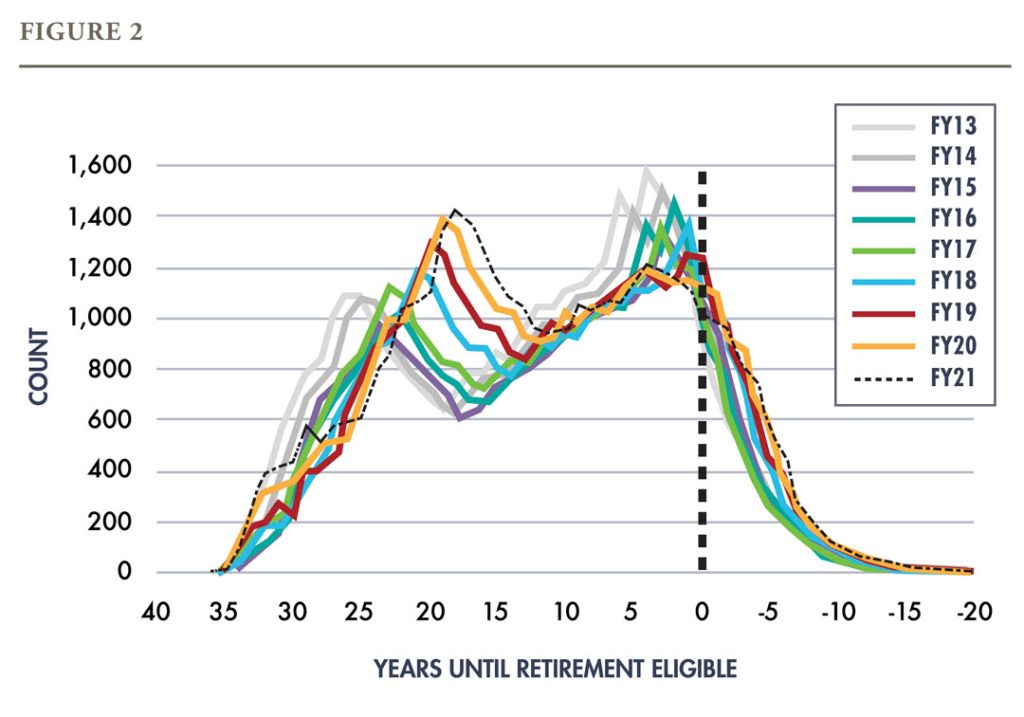
THE OVERVIEW: AAW Civilian Employee Retirement Eligibility Distribution, fiscal years 2013-2021.
There are two other, less obvious, features of Figure 2 worth mentioning. These are the expansion of the distribution’s right- and left-hand tails. These show recently increased early career hiring (left tail), and employees working longer after retirement eligibility (right tail). The latter is an important factor in understanding the generational transition. Simply put, many people do not immediately retire upon reaching eligibility. Consequently, we should not view retirement eligibility as a cliff employees reach and then fall off.
NO SUBSTITUTE FOR EXPERIENCE
Viewing baby boomer retirement by the sheer number of pending retirees is misleading in several important ways. First, it carries with it a hidden assumption. Namely, it assumes all else is equal with regard to those exiting the workforce. But this is simply not true. From an institutional perspective, it is very important to take the time to understand the composition of those going out the door.
Expertise, or skill, is difficult to measure, but if we use experience (or time in the saddle) as a proxy, we can draw some broad conclusions. Figure 3, shows this distribution. The first thing to notice is that the near-retirement-eligible population (aqua line) is nearly uniform from about zero to 30 years of experience. So, we see the retirement-eligible population represents every experience level in the AAW about equally (including acquisition novices). As shown, 30 percent have fewer than 10 years of acquisition experience compared to the entire AAW, where about half (47 percent, dark blue line) have fewer than 10 years of acquisition experience.
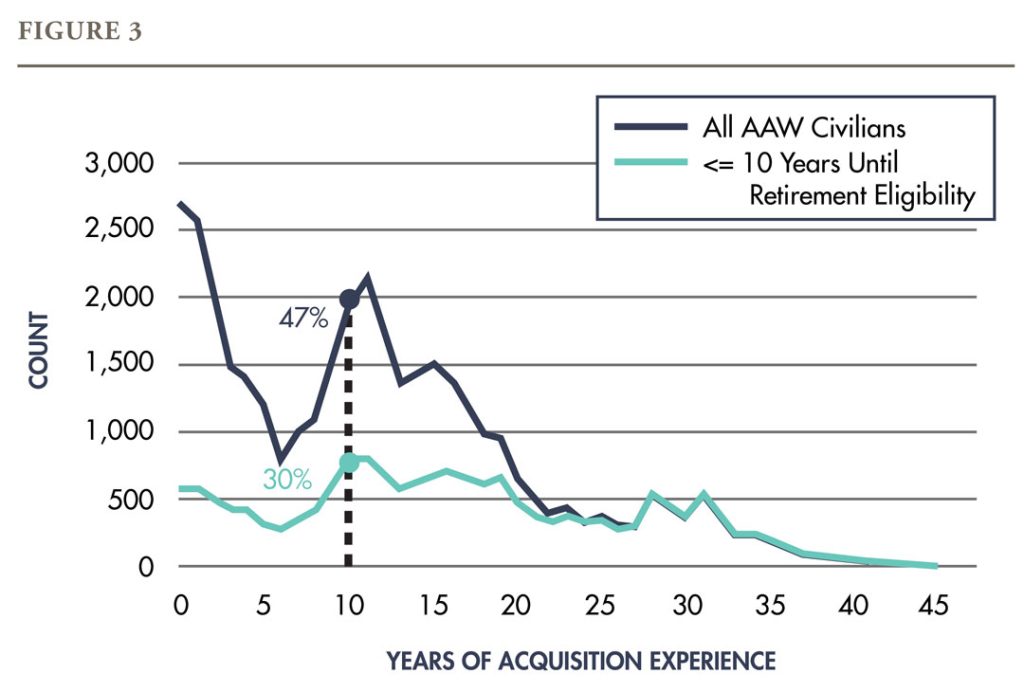
NEAR ELIGIBILITY: This graphic illustrates AAW acquisition experience distribution and the breakout of those within 10 years of retirement eligibility.
TEN THOUSAND HOURS TO MASTERY
Here we should consider research conducted by K.A. Ericsson, R.T. Krampe and C. Tesch-Romer, in a 1993 Psychological Review article, “The role of deliberate practice in the acquisition of expert performance,” studied how people improve. This research was popularized by Malcolm Gladwell in his 2008 book “Outliers.” You may recall that Gladwell articulated his well-known principle of “10,000 hours to mastery.”
In their investigation, Ericsson, Krampe and Tesch-Romer “argue that the differences between expert performers and normal adults reflect a life-long period of deliberate effort to improve performance in a specific domain.” Further, they state that “many characteristics once believed to reflect innate talent are actually the result of intense practice extended for a minimum of 10 years.”
We gain further support for accepting 10 years of experience as the mark of an “expert” from a 2017 Management of Information on Teaching Resources and Employment Corporation Mitre Corp. survey of federal acquisition workforce members, in which 64 percent said it takes at least 10 years to become fully proficient.
Since 20 hours a week over 10 years is about 10,000 hours, it seems reasonable to define an acquisition expert as someone with 10 or more years of “deliberate” (professional) experience. An historical count of such experts in the AAW is shown in Figure 4. It shows that, after increasing from 2013 to 2016, the percentage of AAW experts has been steady since 2016.
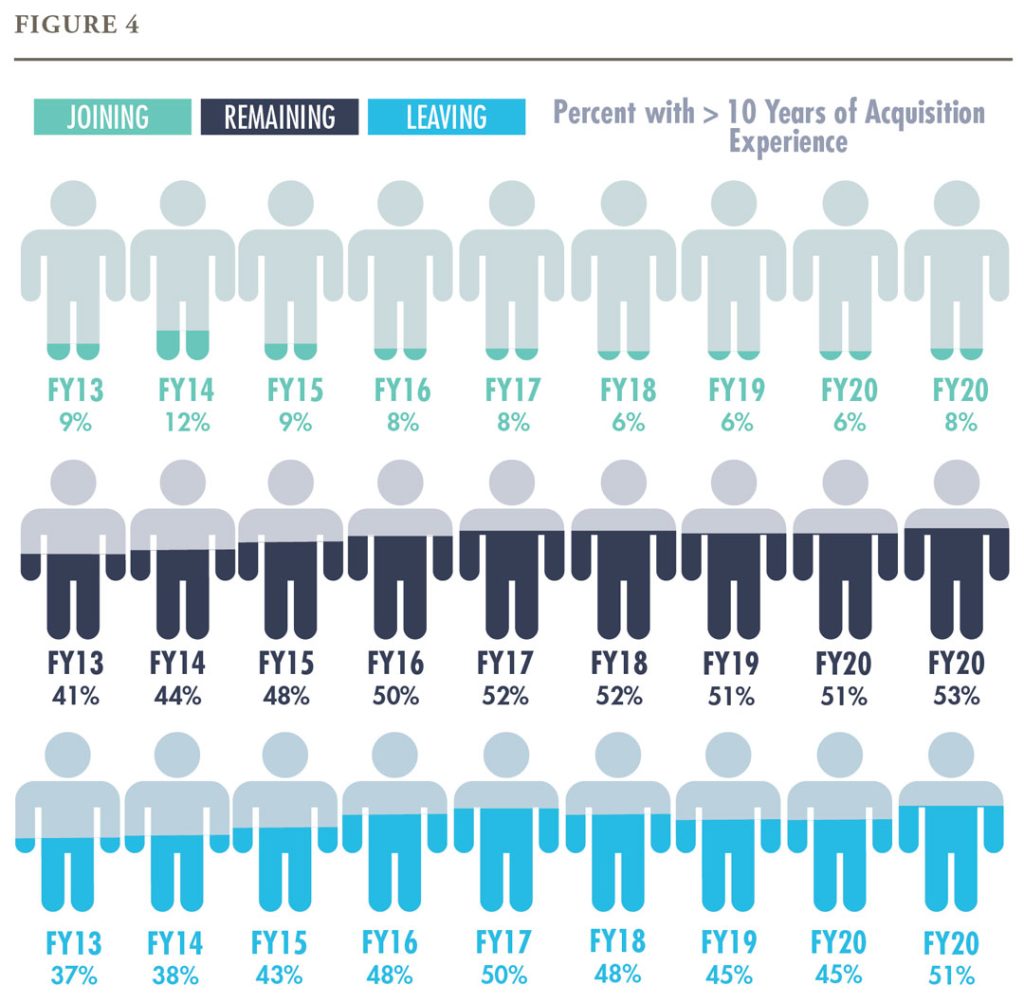
THE EXPERTS: Here is the percentage of employees with 10 more years of acquisition experience joining, staying or leaving the AAW.
This provides us positive, qualitative evidence that the AAW is not currently suffering a widespread brain drain of experience, even though a considerable number of experts are leaving the workforce every year. Additionally, this finding is consistent with a 2018 Professionals Services Council survey of federal officials from across the federal government who reported federal acquisition skills were generally increasing overall.
In addition to these measures, a couple of additional facts are important to keep in view when thinking about the AAW retirement wave. Firstly, on the loss side, most AAW attrition is not among those who are retirement eligible. Rather, about 60 percent of AAW attrition is among those who have not reached retirement eligibility. Then, on the gain side, the distribution of those joining the AAW since 2013 has moved increasingly toward the younger and less experienced (those with more than two decades until they are retirement eligible). These distributions are shown in Figure 5. Finally, and most importantly, we have seen that attrition among these younger workers has been much lower than expected.
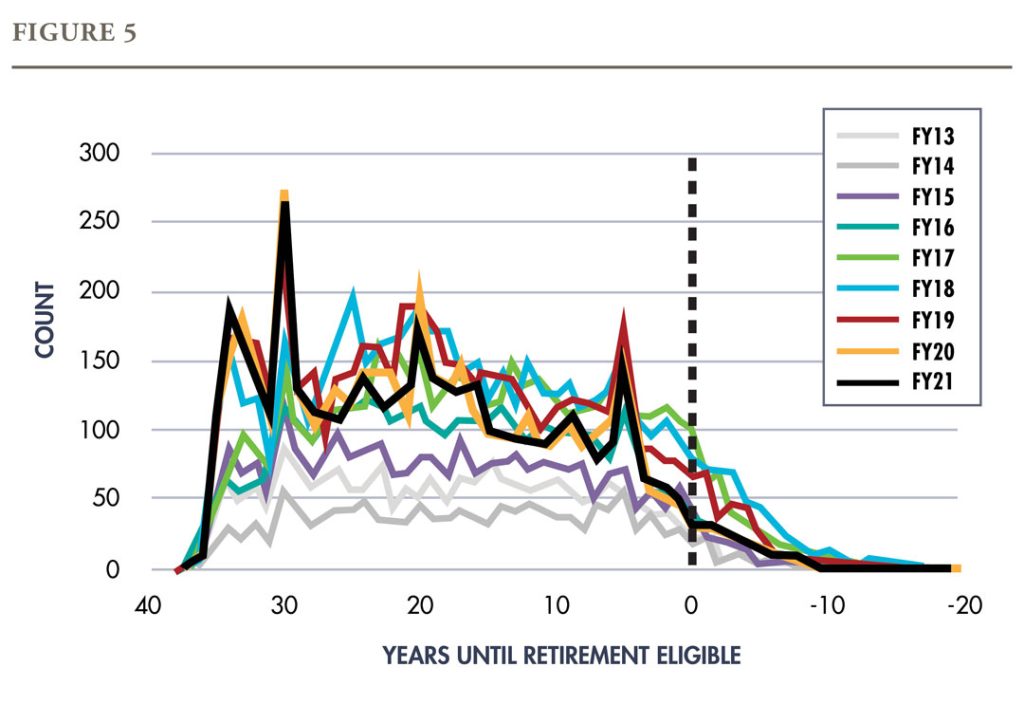
ALL ABOARD: This is the distribution of employees joining AAW since 2013.
WHAT DOES IT ALL MEAN?
Today, millennials are between 25 and 40 years of age, occupying the heart of the high-priority hiring population. Meanwhile, nearly 100 percent of federal baby boomer employees are retirement eligible. Management of the current generational transition between these cohorts has been the subject of years of proactive planning, focused policy implementation and dedicated effort across the AAW enterprise. Together, these actions are proving effective, so that nothing resembling a brain drain has occurred. But, surprises can always lie ahead.
In the near term, these will likely be related to the current pandemic which has already produced several unpredictable workforce changes. For example, the U.S. saw record employee separation rates in 2020 in both the private and government sectors. But as concerning as this has been to many, and as much high-profile media attention as the issue received, in 2021 these rates appear to have reversed and returned to their historic trend (see Figure 6).

SEPARATION PAINS: Here are the annual total separations rates by industry and region—not seasonally adjusted. (Source: U.S. Bureau of Labor Statistics. Graphic by USAASC)
It is important to note that, to date, this separation effect has not been significant in the AAW but, rather, there is evidence that the opposite may be occurring. Thus, to the extent that AAW retention is being buoyed by pandemic influences, like preferences for stable jobs with liberal telework, we should expect the opposite effect if such accommodations are removed.
At the bottom line, individual employee choices are inherently personal and hard to predict. We should continue to monitor the situation and avoid extrapolating trends that, in many cases, have already reversed. Continuous attention and fine-tuning in AAW recruiting, retention and training has enabled enterprise success so far, and it is our best path to remaining successful in the future.

NOW HIRING: DOD has long feared an exodus of knowledge when older employees retire—but those fears appear unfounded. (Photo by Joshua Shinn, Letterkenny Army Depot)
For more information, go to https://federalnewsnetwork.com/mike-causey-federal-report/2019/03/retirement-tsunami-or-aging-in-place/.
DANIEL E. STIMPSON, Ph.D. is an operations research systems analyst and Level III-certified program manager at the U.S. Army Director of Acquisition Career Management Office. He holds a doctorate in systems engineering and operations research from George Mason University, an M.S. in operations research from the Naval Postgraduate School and a B.S. in oceanography from the U.S. Naval Academy.







